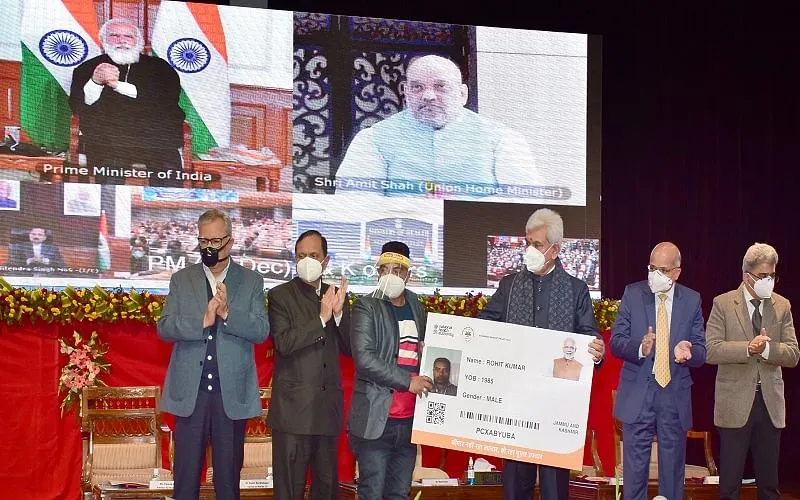When the Ayushman Bharat (AB PM-JAY) Scheme was launched two years ago in J&K, basic flaws in the demographic data confined its access to masses. This shortfall was to be overcome by the newly launched SEHAT scheme. However, before people in J&K start counting on it, some immediate steps need to be taken for it to count.
Most health insurance schemes fail due to the lack of awareness about their existence, functioning and utility. For the SEHAT Scheme, the Government has been upfront to increase the level of awareness about its availability for “every soul in Kashmir”. However, the strategy of relying on mass media only has not translated into uniform clarity across. The literacy and exposure differences among the targeted beneficiaries have resulted in many touts reaping the benefit, fleecing some unsuspecting under-privileged people. Moreover, there are others, especially in the tribal and nomadic populations, who are yet to get a hold of what the scheme could help them with, given their status.
The SEHAT scheme promises Universal Health Insurance Coverage of Rs 5 lakh per family on a floater basis, the same benefits as available under Ayushman Bharat. This scheme covers “all residents of J&K including Government employees/pensioners and those without any regular wages. It pledges “cashless access to health care services for the beneficiary at the hospitals empanelled by Government. “It envisions helping mitigate catastrophic expenditure on medical treatment to all the residents of Jammu & Kashmir. It covers up to 3 days of pre-hospitalization and 15 days post-hospitalization expenses such as diagnostics”.
A recent update from the Government said that till the end of last month, 22 lakh Golden Cards have been issued. This is in addition to the 13.28 lakh cards issued under AB – PMJAY. These numbers add up to 70 percent of people in J&K having the health insurance cover as on date. The update also said that 22000 cashless treatments have been carried out across hospitals. However, any doctor would testify that the card is unable to reprieve people of the burden a health emergency puts on their resources.
The benefits of Golden Card can only be availed by patients that are admitted at the hospitals. The clause, many families allege, makes it impossible for them to avail any gain. “My father has chronic kidney disease and has now been infected with Hepatitis C due to years of dialysis,” said Fayaz Ahmed, a resident of Kupwara. However, despite having the Golden Card, he cannot get the costly drugs needed for his treatment from the hospitals as the treatment does not involve admission. “What is the point of this scheme if it has so many clauses that only rule out conditions and scenarios,” he lamented.
A senior doctor at SKIMS, Soura said that the Institute does not entertain the card for every treatment. “Many a time we tell the patients that a certain investigation would be covered but another one would not be,” she said. She said that for patients this only generates more agony at a time when time could be the difference between life and death.
Similarly, in private sector, barring a few, no hospital is in a position to entertain the Golden Card issued under the scheme. Although many other private health insurance schemes are in vogue and those who can afford such schemes do get the benefit of cashless treatment in the limited private sector of Kashmir, SEHAT fares poorly. Moreover, even at the hospitals empanelled under it, the reluctance breeds from the disparity in approved charges.
A surgeon who works at a private hospital said that the rates for surgery fixed by Government were just about 20-30 percent of the market rates. “For example a surgery of tonsils the rate fixed in only Rs 5000. This covers the hospital room rent, medicines etc,” he said adding that the depreciated costs were “breaking the back of the private sector”. Many hospitals, he said, were not even ready to get empanelled under the scheme as the payments were often delayed by years on the “pretext of verification of documents”. “Poor would only suffer like this,” he said, adding that it was imperative the Government revised its rates and added some provisions like access to medicines, drugs, disposable at affordable costs.
However, given these initial hiccups, SEHAT Scheme could be a boon to families that are often pushed further into the vicious circle of poverty due to a health emergency. Financial Commissioner Health and Medical Education, Atal Dulloo, who, as per many officials in his department, has been closely following the implementation of the scheme, has directed the team to identify the lacunae and work on them. “We are having regular reviews and would definitely make this a success story in J&K,” he told Greater Kashmir.
“The ambitious health insurance scheme is going to be the game-changer as far as the provision of health-care services is concerned. It will on one hand help residents of J&K to avail quality health care services and on the other hand, will strengthen and streamline the supply-side in the health service delivery paradigm” he said.






